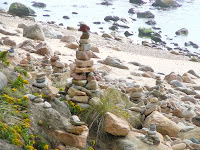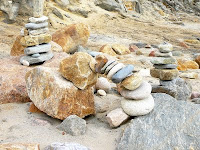
More than 25 years ago we lived for a short while up-county and my friend Lilla and I put ads in the PennySaver and the Ridgefield Press: Looking to Start a Writers Group. Because Lilla, with her Monty-Pythonesque British accent, called in the ad, the person on the other end of the telephone mistook ‘support’ for ‘sport’ and that confused not a few of the intrepid respondents. But amazingly enough, there were respondents, wonderful ones, some who have become lifelong friends.
It was in the spirit of both support and sport that last week four of us from that original writers’ group crossed the waters and landed on Block Island. Mary-Ann’s agent graciously loaned us her house overlooking Rodman’s Hollow, where it just so happens a dead body is discovered in Mary-Ann’s mystery She’s Not There. (Mary-Ann writes sharp & witty mysteries. Also contemporary and historical fiction. Also a wonderful memoir, Girls of Tender Age. Sarah, a writer of romances and travel pieces and restorer of old houses, was our Athletic Director. And when we didn’t take direction, she rode off on her bicycle for an extra 10 miles just to get some exercise. Becky, who writes the highly acclaimed blog about midlife depression, The Blue Hours of Middle Life, provided comic relief.
But I would like to talk of rocks.
It seems that in the 17th and 18th centuries the rocks (called ‘pebbles’, rather in the same way that mansions in Newport are called ‘cottages’) of Block Island were taken across the water and used as cobblestones to pave the streets of the coastal towns of Connecticut. When Becky first informed me of this fact I said, What? You mean they didn’t have their own rocks?
Then I saw the ‘pebbles’ of Block Island and understood.
One day, according to Sarah’s brilliant plan, we left our car at Dorie’s Cove and then rode our bikes over to Mohegan Bluffs, because at low tide it is possible to walk all the way around the southern end of the island, from the bluffs to the cove. And there are rocks all the way, some of the finest you will ever see. There are over 100 stairs leading down from the bluff to the beach, which is to say it is a long way down.
When we arrived at sea level, we discovered to our amazement and wonder that the druids, the stonemasons, Saints Antoninus and Marinus, had all been there before is. The rocky beach was full of cairns, some more vertical than others, some petite and understated, some large and brazen; some were perilous feats of balance and a few incorporated driftwood.

What is it in us that compels us to build piles of stones? To gather stones, to move stones from place to another, to lay stone upon stone upon stone? How can we explain the deep satisfaction of choosing the right stone to rest upon another stone? Since ancient times cairns have been built to mark graves and paths and sacred places. Not all that long ago I arrived at my brother’s house in New Hampshire and saw that someone, an artist of stones, had built delicate balancing acts of stones and boulders, atop the already solid stone wall. It turned out the artist was a nephew who will always have a smooth rock in his pocket.
The cairns of Mohegan took our breath away. Of course they were beautiful, but there were so many and of such various artistic styles. Looking up at the imposing bluffs, we imagined that the first cairns were built in homage to that rocky face, and then subsequent cairns were built to join in, and then further cairns were built to honor the community.

While there are no specific patron saints of cairns, stonecutters and stonemasons are well supplied with patron saints. Though – and this should surprise no one – the patrons are not the saints who were in fact stonecutters.
Saint Antoninus, for instance, was a 4th century Syrian stonemason known for castigating the locals for worshipping stone images. After making himself unpopular, he went off to become a hermit.

Saint Marinus (5th century) is credited with being the namesake of tiny San Marino. A stonemason and a lifelong bachelor, a lunatic lady accused him of being her estranged husband, and he had to flee to a cave where he lived as a hermit. (Is this a pattern?)
Neither of them are patron saints of stonecutters.
 Rather, we have Saint Stephen, the proto-martyr, stoned to death, one of the all-time favorite scenes of martyrdom in art, q.v.: Fra Angelico, Ghirlandaio, Fouquet, Donatello, Foppa, Rubens, Vasari, Uccello, Cavallino, Carpaccio. Who would have thought throwing stones at a handsome young man would be so popular?
Rather, we have Saint Stephen, the proto-martyr, stoned to death, one of the all-time favorite scenes of martyrdom in art, q.v.: Fra Angelico, Ghirlandaio, Fouquet, Donatello, Foppa, Rubens, Vasari, Uccello, Cavallino, Carpaccio. Who would have thought throwing stones at a handsome young man would be so popular? 
Then we have Saint Reinhold (10th century) who supervised the stonemasons building the monastery of Saint Pantaleon. His diligence so enraged the masons that they killed Reinhold with their hammers and threw his body into the Rhine. For that, he too is a patron saint of stonecutters.
I prefer the cairn builders of Block Island to the martyrs, but there are enough pebbles on the beach for all of us.






2 comments:
Don't you think it would have been masochistic for saints to work with stones?
And, we're not in the least surprised that it would be ancient sport throwing stones at gorgeous young men. Especially by sloven grotesque older ones, of which we know there were/are many.
Block Island rocks, or pebbles if you will, are a great favorite of mine. My husband and I vacationed there for ten years before we felt the need for warmer water and moved our vacations to the Caribbean. I have been on that beach at the bottom of Mohegan Bluffs, and I have also built a cairn or two there. I enjoyed reading your post.
Post a Comment